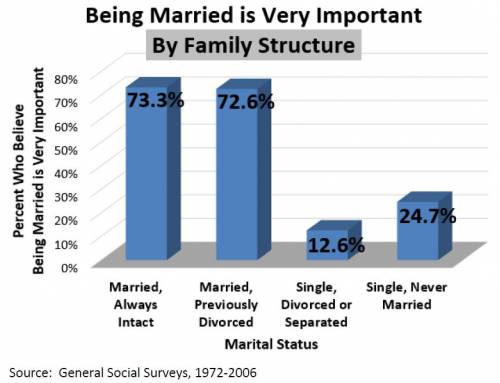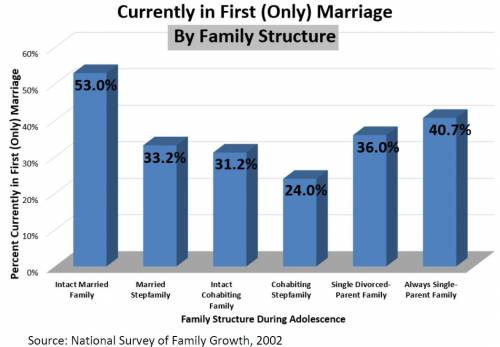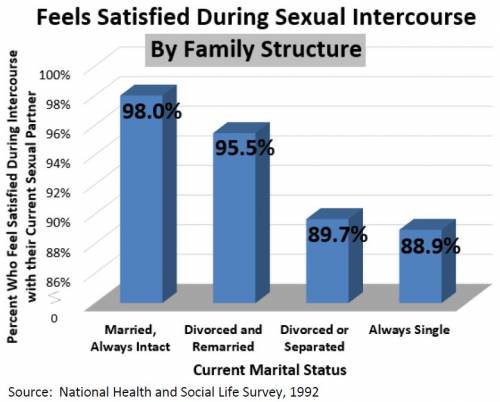Effects of Marriage on Couple's Relationship
1. Happiness
Those who marry experience increased commitment and stability.1) Men raised in married families have more open, affectionate, and cooperative relationships with the women to whom they are attracted to than do those from divorced families.2) Correspondingly, married mothers report more love and intimacy in their romantic/spousal relationships than cohabiting or single mothers.3) Those raised in married families have higher expectations of eventually marrying,4) and a larger fraction of those from intact families than non-intact families are happy in their marriages.5) Similarly, a lower percentage of those raised in intact families divorce.6)
Daughters raised in intact families are less likely to say they do not plan to have children than daughters living with divorced or remarried mothers.7) In contrast, cohabiting couples enjoy diminished relational happiness and fairness and increased relational disagreement and violence, relative to married couples. When duration of cohabitation was factored in, cohabitation’s effect became nonsignificant, but increased duration of cohabitation worsened happiness, disagreement, and violence.8)
1.1 Related American Demographics
A larger fraction of those in always-intact marriages report that being married is very important to them, compared to those who are divorced, single, or remarried (although these may also regard marriage as important).9) (See Chart)
The 2002 cycle of the National Survey of Family Growth showed that among adults aged 38 to 44, staying in one’s first and only marriage is most common among those raised in an intact married family.10) (See Chart Below)
2. Sexual Experience
Studies show that married men and women report the most sexual pleasure and fulfillment.11) Married men and women report having more enjoyable sexual intercourse more often,12) and married couples find their sexual relationship more satisfying than cohabiters do.13)
2.1 Related American Demographics
The National Health and Social Life Survey shows that those in always-intact marriages were most likely (91.3 percent) to report feeling thrilled and excited during intercourse with their current sexual partner, followed by those who were divorced and remarried (88.9 percent), those who were always single (82.7 percent), and those who were divorced or separated (81.8 percent). 14) (See Chart Below)
A larger fraction of individuals in intact marriages than always-single, divorced or separated, or divorced and remarried persons report “very, extremely” enjoying intercourse with their current sexual partner.15) Likewise, a larger fraction of individuals in intact marriages than always-single, divorced or separated, or divorced and remarried persons report feeling satisfied,16) (See Chart Below) loved,17) “taken care of,”18) and thrilled or excited19) during intercourse with their current sexual partner. Those in always-intact marriages were most likely to report feeling wanted and needed during intercourse (92 percent).20) These feelings are less prevalent in non-intact family structures and among singles.
Correspondingly, a smaller fraction of individuals in intact marriages than always-single, divorced or separated, or divorced and remarried persons report feeling guilty,21) sad,22) or scared or afraid23) (See Chart Below) during intercourse with their current sexual partner. Those in always-intact marriages were the least likely to feel anxious or worried during intercourse with their current sexual partner (6.8 percent). Feeling anxious or worried during intercourse is more prevalent among those in non-intact structures and among singles: 12.1 percent of those who were divorced and remarried, 20.6 percent of those who were divorced or separated, 25.9 percent of those who were always single feel anxious or worried during intercourse with their current sexual partner. 24)

G.K. Rhoades, et al. “Parents' Marital Status, Conflict, and Role Modeling: Links with Adult Romantic Relationship Quality,” Journal of Divorce & Remarriage 53, no. 5 (2012): 358.
Jay D. Teachman, “Childhood Living Arrangements and the Intergenerational Transmission of Divorce,” Journal of Marriage and Family 64, (2002): 717–729. As cited by The Heritage Foundation: Family Facts. Available at http://www.familyfacts.org/briefs/39/family-environment-and-childrens-prospects-for-marriage. Accessed 20 July 2011.
Larry Bumpass, James Sweet, and Andrew Cherlin, “The Role of Cohabitation in Declining Rates of Marriage,” Journal of Marriage and the Family 53, no. 4 (1991): 923.
Scott Stanley, Sarah Whitton, and Howard Markham, “Maybe I Do: Interpersonal Commitment and Premarital or Nonmarital Cohabitation,” Journal of Family Issues 25, no. 4 (2004): 507-508.
Patrick F. Fagan and Althea Nagai, “‘The Personal Importance of Being Married’ by Marital Status.” Available at http://marri.us/wp-content/uploads/MA-82-84-176.pdf. Accessed 1 September 2011.
Patrick F. Fagan and Paul Sullins, “'Currently in First (Only) Marriage' by Structure of Family of Origin and religious Upbringing,” Mapping America Project. Available at http://marri.us/wp-content/uploads/MA-135.pdf
Edward O. Laumann, et al., The Social Organization of Sexuality: Sexual Practices in the United States (Chicago: University of Chicago Press, 1994), 364, table 10.5
Andrew Greeley, Faithful Attraction: Discovering Intimacy, Love and Fidelity in American Marriage (New York: Tom Doherty Association, 1991), chapter 6. As cited in G.T. Stanton, “Why Marriage Matters.” Available at http://www.ampartnership.org/resourcecenter/news/89-why-marriage-matters.html. Accessed 27 July 2011.
D.M. Busby, J.S. Carroll, and B.J. Willoughby, “Compatibility or Restraint? The Effects of Sexual Timing on Marriage Relationships,” Journal of Family Psychology 24, no. 6 (2010): 766, 772.
This entry draws heavily from 164 Reasons to Marry.



